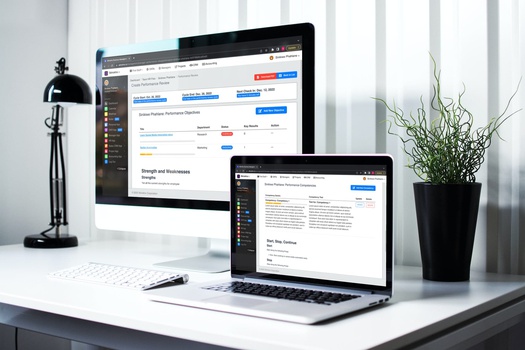The Evolution of Performance Management: From Traditional to Modern Approaches
Performance Management has been a part of the workplace for centuries, starting with traditional, bureaucratic models that focused on controlling and monitoring employee behavior through annual evaluations and performance appraisal. Over time, there has been a shift towards more progressive and employee-centered approaches, recognizing the importance of frequent feedback and development, employee engagement, and data-driven decision making. With the changing demands of the workforce and advancements in technology, performance management continues to evolve towards more modern and dynamic models.
This blog will focus on the following main topics:
- Traditional Performance Management Process
- The Shift to Modern Day Performance Management Process
- Key Elements of Modern Performance Management
- The need for a change
- Implementing Modern Performance Management
- Final thoughts and recommendations
Traditional Performance Management Process

Definition of traditional performance management
This approach is characterised by top-down decision making, rigid job descriptions, and a focus on past performance rather than future potential. It often relies on a single, annual performance reviews to determine an employee's value to the organization, leading to a lack of regular feedback and opportunities for growth.
Additionally, it often utilises a subjective and evaluative process, relying on the opinions of a single manager rather than objective measures of performance. This can result in subjective and inconsistent evaluations, leading to low employee morale and engagement.
Limitations of traditional performance management process
The following are the main limitations of the traditional approach:
- Bureaucratic Approach: It can be bureaucratic and rigid, limiting opportunities for innovation and flexibility.
- Annual Evaluations: Performance is evaluated through a single, annual performance review, which can lead to a lack of timely feedback and opportunities for growth.
- Top-Down Decision Making: Decisions about employee performance are made by a single manager, leading to a lack of employee empowerment and autonomy.
- Job Descriptions: It often relies on rigid job descriptions, limiting the scope for employee creativity and flexibility.
- Focus on Past Performance: It is focused on evaluating past performance, rather than future potential or growth, leading to a lack of opportunities for continuous improvement.
- Subjective Evaluations: Evaluations are subjective, relying on the opinions of a single manager, leading to potential biases and inconsistencies.
- Lack of Employee Engagement: It often lacks opportunities for employee engagement and empowerment, leading to low morale and motivation.
- Lack of Continuous Feedback: It does not provide regular feedback, limiting opportunities for growth and development.
The Shift to Modern Day Performance Management Process

Definition of modern performance management systems
Modern Performance Management system is a progressive approach to managing employee performance that focuses on continuous feedback, growth, and development. It is characterized by a bottom-up decision making structure, regular feedback, and a focus on future potential and growth. In the modern approach, performance is evaluated through ongoing, two-way communication between employees and managers, and objectives are set collaboratively to align with the organization's goals. The overall aim of this modern approach is to foster a culture of continuous learning, employee development, and personal growth, leading to increased employee productivity and engagement.
Characteristics of modern performance management
The following are the main characteristics of modern performance management:
- Collaborative Approach: It is a collaborative approach, relying on two-way communication and regular feedback between employees and managers.
- Continuous Feedback: Performance is evaluated through ongoing feedback, providing opportunities for growth and development.
- Bottom-Up Decision Making: Decisions about employee performance are made through collaboration between employees and managers, leading to increased autonomy and empowerment.
- Flexible Objectives: Objectives are set collaboratively and are flexible, allowing for continuous adaptation and improvement.
- Focus on Future Potential: It focuses on future potential and growth, rather than solely on past performance.
- Regular Communication: Regular, two-way communication is emphasized in modern performance management, leading to increased transparency and trust.
- Employee Engagement: Modern performance management places a strong emphasis on employee engagement and empowerment, leading to increased motivation and productivity.
- Continuous Learning: Modern performance management fosters a culture of continuous learning and development, leading to increased opportunities for growth and improvement.
Advantages of modern performance management
Modern performance management offers numerous advantages over traditional approaches, leading to improved employee performance and satisfaction. With its focus on effective feedback, collaboration, and growth, modern performance management encourages employee engagement and empowerment, leading to increased motivation and productivity. The flexible, adaptable nature of modern performance management allows for real-time alignment with organizational goals, leading to companies obtaining good performance and a culture of continuous learning and improvement.
Additionally, the new model emphasises regular, two-way communication, leading to increased transparency, trust, and collaboration between employees and managers. Overall, modern performance management represents a significant improvement over traditional approaches, leading to a more engaged, motivated, and productive workforce.
Key Elements of Modern Performance Management
We'll explore the key elements of the modern approach and why they are critical to the success for many organizations. From flexible objectives and ongoing feedback to employee engagement and continuous learning, we'll examine how these elements contribute to a more dynamic, productive, and motivated workforce.
#1. Continuous Feedback and Development
Continuous Performance Feedback and Development is a key element of modern performance management. In the traditional approach, feedback was often given annually or bi-annually in the form of a performance review. However, in modern performance management, feedback is given regularly and continuously, providing opportunities for growth and development on an ongoing basis. This type of feedback is not just limited to performance reviews, but also includes regular check-ins and two-way communication between employees and managers.
It encourages a culture of learning and development, and helps employees identify areas for improvement and set realistic, achievable goals. It also provides managers with the opportunity to recognize and reward outstanding performance in real-time, leading to increased motivation and satisfaction. Additionally, continuous feedback can help organizations identify and resolve performance-related issues quickly, leading to improved overall performance and a more productive workforce. It plays a critical role in modern performance management, fostering a culture of growth and improvement and leading to increased employee engagement and productivity.

#2. Employee Engagement and Empowerment
Employee Engagement and Empowerment is another key element of modern performance management. Unlike traditional management process, which was often top-down and bureaucratic, modern performance management places a strong emphasis on bottom-up decision making and empowering employees. This approach encourages employee engagement and fosters a sense of ownership, self organization and responsibility for performance.
Employee engagement is critical to the success of any organization, as engaged workers are more motivated, productive, and committed to their work. Modern performance management promotes employee engagement by empowering employees to take control of their performance and development, and by providing regular feedback and opportunities for growth.
Overall, employee engagement and empowerment are essential components of modern performance management, leading to a more motivated, productive, and engaged workforce.
#3. Data-driven Decision Making
Data-driven decision making is a key element. In the traditional approach, decisions were often based on intuition, experience, or subjective opinions. However, modern performance management relies on hard data and metrics to make informed decisions about employee performance and development.
Data-driven decision making provides organizations with a clear and objective picture of employee performance, enabling them to identify areas of strength and weakness and make informed decisions about development and training. This data-driven approach helps managers make fair and consistent decisions about promotions, bonuses, and other rewards, and provides employees with clear, actionable feedback about their performance.
In addition, data-driven decision making allows organizations to track the success of their performance management programs and make informed decisions about improvements and changes. By using data and analytics, organizations can make informed decisions about the effectiveness of their performance management strategies, leading to continuous improvement and better overall results.
#4. Collaborative Goal Setting
Collaborative Goal Setting is a key element of modern performance management. In the traditional approach goals were often set by management and imposed on employees, leading to a lack of motivation and engagement. Modern performance management, however, places a strong emphasis on collaboration and involvement in the goal-setting process.
Collaborative goal setting involves employees in the process of setting and achieving goals, leading to increased motivation and ownership. This approach encourages employees to take an active role in their own performance and development, and helps managers understand their employees' needs and priorities.
Collaborative goal setting also provides employees with clear and achievable objectives, reducing the risk of confusion and frustration. It also enables managers to provide continuous feedback and support, leading to improved performance and a more productive workforce.
Overall, by involving employees in the goal-setting process and providing them with clear and achievable objectives, organizations can create a more dynamic, productive, and motivated workforce.
The Need For a Change
The need for a change in Performance Management Systems stems from several factors. Firstly, the traditional process of annual evaluations and performance appraisals is no longer effective in today's fast-paced and dynamic work environment. It fails to provide constructive feedback and opportunities for growth, leading to low employee motivation and engagement.
Secondly, the increasing emphasis on data and analytics in business decision making has highlighted the need for performance management to be data-driven, providing more accurate and objective measures of employee's performance.
Finally, the changing nature of work and the importance of employee empowerment and autonomy have made it necessary for performance management to become more collaborative and flexible, allowing employees to take ownership of their performance improvement. Overall, the need for change in performance management is driven by the need for more effective and employee-centered approaches that support business objectives and improving performance and engagement.

Implementing Modern Performance Management
Implementing Modern Performance Management can be a significant change for organizations, but it is essential to ensure success in today's fast-paced business environment. Here are some steps organizations can take to implement modern performance management:
- Assess current practices
- Define objectives
- Involve employees
- Provide training
- Monitor and evaluate
Overall, implementing modern performance management requires careful planning, collaboration, and a commitment to continuous improvement. By taking these steps, organizations can create a performance management system that leads to increased employee engagement, productivity, and success.
Overcoming resistance to change
Overcoming resistance to change is a critical component of implementing modern performance management. While many employees and managers may welcome the new approaches and benefits of modern performance management, some may be resistant to change, leading to potential challenges and obstacles. Here are some tips for overcoming resistance to change:
- Communicate effectively: Clearly communicate the reasons for change and the benefits of modern performance management. This will help employees understand the rationale behind the changes and see the potential benefits for themselves and the organization.
- Involve employees: Involve employees in the implementation process and gather their feedback and input. This will help employees feel that they are being heard and valued, and that their opinions matter.
- Provide training and support: Provide training and support to managers and employees, ensuring they understand the new system and have the skills they need to succeed. This can include workshops, webinars, and on-the-job training.
- Address concerns: Address the concerns and objections of employees and managers, and work to find solutions that meet their needs. This may involve adjusting the new system or providing additional support and training.
- Lead by example: Lead by example, demonstrating a commitment to modern performance management and the benefits it can bring. This will help encourage employees and managers to embrace the changes and work towards a common goal.
Overall, overcoming resistance to change is an important component of implementing modern performance management. By communicating effectively, involving employees, providing training and support, addressing concerns, and leading by example, organizations can help employees and managers embrace the changes and work towards a more productive and successful future.
Measuring the impact of modern performance management
Measuring the impact of modern performance management is essential for evaluating its success and making improvements. Here are some key metrics to consider:
- Employee engagement: Track employee engagement levels to see if the new approaches have increased engagement and motivation.
- Goal attainment: Monitor the attainment of individual and organizational goals to see if they are being met and if progress is being made.
- Productivity: Track productivity levels to see if modern performance management has improved efficiency and output.
- Retention rates: Monitor employee retention rates to see if modern performance management has improved employee satisfaction and reduced turnover.
- Feedback and improvement: Collect feedback from employees and managers and use it to evaluate the impact of modern performance management and identify areas for improvement.
- Cost savings: Track cost savings from reduced turnover and improved productivity to see if modern performance management is delivering value for the organization.
- Goal alignment: Monitor the alignment of individual and organizational goals to see if modern performance management is promoting a common vision and purpose.
Measuring the impact of modern performance management will help organizations understand its success and identify areas for improvement. By tracking key metrics, organizations can make informed decisions about changes and ensure they are delivering value for the organization and its employees.
Final thoughts and recommendations
Many organizations often seek for a proper team management software to help them with performance management for their employees. Skhokho offers the best solution for all types of businesses.

Skhokho is a business Management Software which offers a convenient solution for businesses with running day-to-day operations. It comes with many apps from HR to Accounting app, but what makes it even more nicer is that you get to pay only for what you need click here to view the pricing page. Don't worry about payments, you can take advantage of their 14 day-free trial, no credit card information required, just click here to register an account and test it out before you make any commitments. For a guide on how to find your way around Skhokho Manager App, click here to read their documentation.
Skhokho's integration of a manager app into its business management software streamlines the performance management process for managers. The performance review feature within the app allows managers to easily set goals and objectives for their employees, track progress, and provide regular feedback. This helps to ensure that employees are aligned with the organization's goals and working towards their professional development.

Additionally, the use of technology in performance management allows for real-time data tracking and analysis, which can provide valuable insights into performance trends and areas for improvement. Overall, Skhokho's manager app offers a more efficient and effective way for managers to manage employee performance and drive business success.









